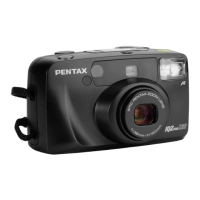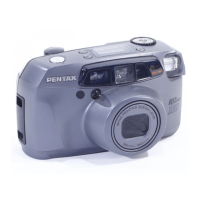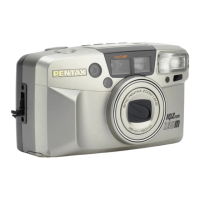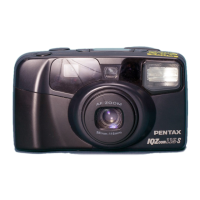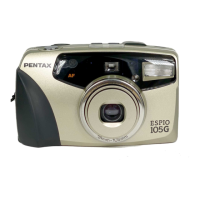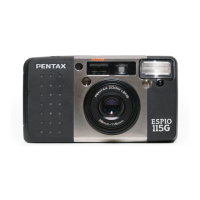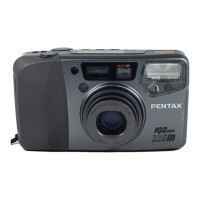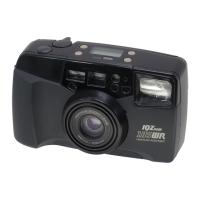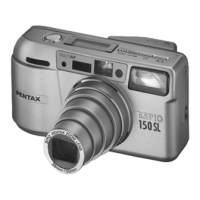Do you have a question about the Pentax IQZoom 140 and is the answer not in the manual?
Explains symbols for operation, status, and correctness.
Identifies buttons like Shutter Release, Drive, Mode, and AF/Infinity-Landscape.
Locates LCD panel, flash, autofocus window, viewfinder, and lamps.
Includes strap lug, lens, self-timer lamp, and remote receiver.
Instructions for opening, closing, and film advance.
How to turn the camera on/off and operate zoom/focus.
Steps for shooting and automatic film rewinding.
Warnings about water, impact, vibration, and environmental factors.
Guidance on cleaning and handling the camera safely.
Advice on storing the camera to prevent damage.
Details on operating temperature, composition, and maintenance.
Instructions on battery insertion, misuse, and storage.
Methods for achieving sharp focus in various scenarios.
Using the flash for better lighting in different conditions.
Adjusting the lens magnification for composition.
Tips for photographing people and scenic views.
Advice on multi-frame shots, distant subjects, and date imprinting.
How to attach the camera strap securely.
How to turn the camera power on and off.
How to verify the battery status.
Correct grip and posture for stable shooting.
Guide to using the camera's zoom function.
Information on compatible film formats and ISO ratings.
Step-by-step instructions for loading film.
Explains viewfinder symbols and shooting distance limits.
Meaning of the indicator lamps on the camera.
How to take standard pictures.
Adjusting the viewfinder for clear vision.
How the LCD panel backlight activates.
General instructions for capturing images.
Process for removing exposed film from the camera.
How to rewind film before the end of the roll.
Guide to choosing exposure modes and red-eye reduction.
Using drive and AF/Infinity-Landscape buttons for modes.
Causes and reduction of red-eye in photos.
How to use flash in bright or backlit conditions.
Using slow speeds without flash for ambient light.
Balancing foreground flash with background exposure.
Long exposures controlled by holding the shutter button.
Combining Bulb mode with flash for night portraits.
How to include yourself in photos using the self-timer.
Using the remote for triggering the shutter from a distance.
Identifies controls and explains blinking lamp during remote use.
Composing and shooting with the remote transmitter.
Focus cannot be locked when using the remote.
Maximum distance and situations affecting remote performance.
Information on battery usage and replacement for the remote.
Steps to superimpose multiple images on one frame.
Capturing sharp distant subjects or scenes through windows.
Focusing on a specific point within the frame.
How to lock focus on a subject for recomposition.
Method to cancel focus lock by releasing the shutter button.
How to change the camera to panoramic mode.
Instructions for processing panoramic film at the lab.
Details on exposure, printing, and cropped areas.
How to select date imprint formats (Year/Month/Day, etc.).
Adjusting the date and time settings for imprinting.
Notes on data imprinting limitations and visibility.
Information on when and how to replace the battery.
Step-by-step guide for inserting a new battery.
Reasons why the shutter may not release.
Causes for unclear or blurry printed pictures.
Problems with lens retraction, remote operation, and flash.
Problems with specific marks appearing on the LCD.
Details on camera build, compatible film, and image format.
Specifications for the zoom lens, autofocus, and shutter.
Details on self-timer function and viewfinder specifications.
Exposure range, flash modes, effective ranges, and remote specs.
Battery performance, exhaustion, and date model features.
Details on the 12-month warranty and service return process.
Information on costs for shipping and servicing, and warranty limitations.
Costs borne by the sender for shipping and customs.
How temperature affects the LCD display's performance.
Identifies dials, switches, levers, and buttons on the camera.
Locates windows, sockets, and covers for access and function.
Symbols for battery exhaustion and flash modes.
Symbols for various shooting modes like AF, Panorama, Timer.
Symbols for exposure count and film rewinding.
| Film Format | 35mm |
|---|---|
| Focus | Auto Focus |
| Zoom | 3.7x |
| Exposure Control | Automatic |
| Flash | Built-in |
| Type | Compact |
| Lens | 38-140mm |
| Shutter Speed | 1/400 - 1/4 sec |
| Film Speed | ISO 25-3200 |
